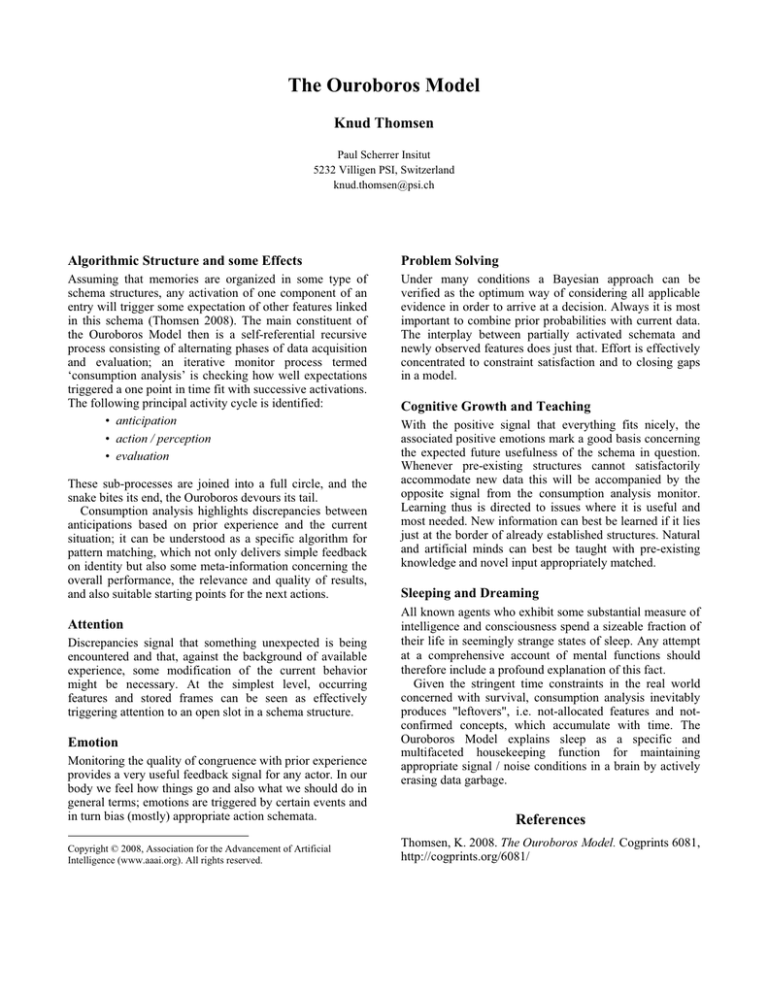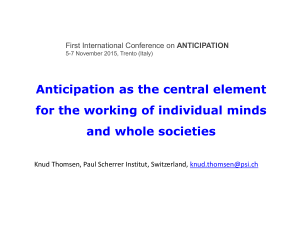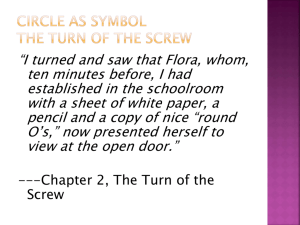
The Ouroboros Model
Knud Thomsen
Paul Scherrer Insitut
5232 Villigen PSI, Switzerland
knud.thomsen@psi.ch
Algorithmic Structure and some Effects
Problem Solving
Assuming that memories are organized in some type of
schema structures, any activation of one component of an
entry will trigger some expectation of other features linked
in this schema (Thomsen 2008). The main constituent of
the Ouroboros Model then is a self-referential recursive
process consisting of alternating phases of data acquisition
and evaluation; an iterative monitor process termed
‘consumption analysis’ is checking how well expectations
triggered a one point in time fit with successive activations.
The following principal activity cycle is identified:
• anticipation
• action / perception
• evaluation
Under many conditions a Bayesian approach can be
verified as the optimum way of considering all applicable
evidence in order to arrive at a decision. Always it is most
important to combine prior probabilities with current data.
The interplay between partially activated schemata and
newly observed features does just that. Effort is effectively
concentrated to constraint satisfaction and to closing gaps
in a model.
These sub-processes are joined into a full circle, and the
snake bites its end, the Ouroboros devours its tail.
Consumption analysis highlights discrepancies between
anticipations based on prior experience and the current
situation; it can be understood as a specific algorithm for
pattern matching, which not only delivers simple feedback
on identity but also some meta-information concerning the
overall performance, the relevance and quality of results,
and also suitable starting points for the next actions.
Attention
Discrepancies signal that something unexpected is being
encountered and that, against the background of available
experience, some modification of the current behavior
might be necessary. At the simplest level, occurring
features and stored frames can be seen as effectively
triggering attention to an open slot in a schema structure.
Emotion
Monitoring the quality of congruence with prior experience
provides a very useful feedback signal for any actor. In our
body we feel how things go and also what we should do in
general terms; emotions are triggered by certain events and
in turn bias (mostly) appropriate action schemata.
Copyright © 2008, Association for the Advancement of Artificial
Intelligence (www.aaai.org). All rights reserved.
Cognitive Growth and Teaching
With the positive signal that everything fits nicely, the
associated positive emotions mark a good basis concerning
the expected future usefulness of the schema in question.
Whenever pre-existing structures cannot satisfactorily
accommodate new data this will be accompanied by the
opposite signal from the consumption analysis monitor.
Learning thus is directed to issues where it is useful and
most needed. New information can best be learned if it lies
just at the border of already established structures. Natural
and artificial minds can best be taught with pre-existing
knowledge and novel input appropriately matched.
Sleeping and Dreaming
All known agents who exhibit some substantial measure of
intelligence and consciousness spend a sizeable fraction of
their life in seemingly strange states of sleep. Any attempt
at a comprehensive account of mental functions should
therefore include a profound explanation of this fact.
Given the stringent time constraints in the real world
concerned with survival, consumption analysis inevitably
produces "leftovers", i.e. not-allocated features and notconfirmed concepts, which accumulate with time. The
Ouroboros Model explains sleep as a specific and
multifaceted housekeeping function for maintaining
appropriate signal / noise conditions in a brain by actively
erasing data garbage.
References
Thomsen, K. 2008. The Ouroboros Model. Cogprints 6081,
http://cogprints.org/6081/




